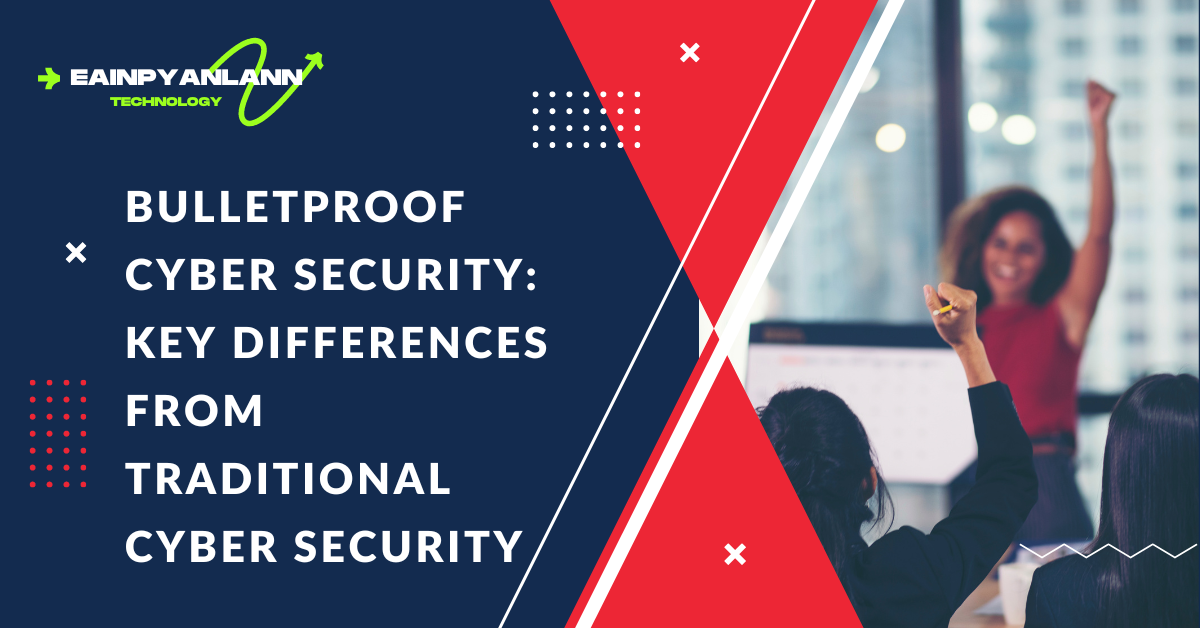In an era where cyber threats are increasingly sophisticated and pervasive, achieving bulletproof cyber security is essential for protecting your organization’s assets. While traditional cyber security measures offer a foundational level of protection, bulletproof cyber security represents a more advanced, comprehensive approach designed to defend against even the most complex and evolving threats. This guide explores the key differences between bulletproof cyber security and traditional cyber security and outlines why a bulletproof approach is crucial for modern businesses.

1. Definition and Scope
1.1. Traditional Cyber Security
Traditional cyber security focuses on implementing basic protective measures to address common threats. This approach typically includes:
- Firewall Protection: Basic firewalls to block unauthorized access.
- Antivirus Software: Programs designed to detect and remove known malware.
- Password Protection: Simple password policies and user authentication methods.
Traditional cyber security often relies on reactive measures, addressing threats after they occur rather than proactively preventing them.
1.2. Bulletproof Cyber Security
Bulletproof cyber security encompasses a comprehensive, multi-layered strategy designed to offer maximum protection. Key elements include:
- Advanced Threat Detection: Utilizing cutting-edge tools and techniques to identify and mitigate emerging threats.
- Proactive Defense Mechanisms: Implementing strategies to anticipate and prevent potential attacks.
- Holistic Security Posture: Addressing all aspects of security, from network and endpoint protection to data encryption and incident response.
Bulletproof cyber security is proactive and adaptive, aimed at staying ahead of evolving threats and minimizing risk effectively.
2. Threat Detection and Response
2.1. Traditional Cyber Security
Traditional cyber security often employs basic detection methods:
- Signature-Based Detection: Identifies threats based on known signatures or patterns.
- Manual Monitoring: Regular review of security logs and alerts to detect suspicious activities.
This approach may struggle to identify new or sophisticated threats that use advanced evasion techniques.
2.2. Bulletproof Cyber Security
Bulletproof cyber security uses advanced detection and response technologies:
- Behavioral Analysis: Monitors user and network behavior to detect anomalies indicative of potential threats.
- Artificial Intelligence (AI) and Machine Learning (ML): Leverages AI and ML to analyze large volumes of data and identify patterns associated with emerging threats.
- Automated Response: Implements automated systems to quickly address detected threats and minimize impact.
This approach provides a more comprehensive and adaptive threat detection capability, enhancing the ability to respond to sophisticated attacks.
3. Risk Management and Mitigation
3.1. Traditional Cyber Security
Traditional risk management practices often include:
- Patch Management: Regular updates to address known vulnerabilities.
- Basic Access Controls: Standard user access policies and permissions.
Risk management in traditional cyber security may be limited to addressing known vulnerabilities and reactive measures.
3.2. Bulletproof Cyber Security
Bulletproof cyber security adopts a strategic approach to risk management:
- Risk Assessment and Analysis: Conducts thorough, ongoing risk assessments to identify potential threats and vulnerabilities.
- Continuous Monitoring: Employs continuous monitoring tools to detect and address emerging risks in real-time.
- Incident Response Planning: Develops and maintains a detailed incident response plan for effective handling of security incidents.
This approach focuses on anticipating and mitigating risks before they impact the organization.
4. Security Policies and Procedures
4.1. Traditional Cyber Security
Traditional policies and procedures often involve:
- Basic Policies: Standard policies for password management, data protection, and access control.
- Limited Scope: Policies may not cover all potential security scenarios or adapt to new threats.
Policies in traditional cyber security are typically designed to address common threats and may not be comprehensive enough for modern security needs.
4.2. Bulletproof Cyber Security
Bulletproof cyber security includes:
- Comprehensive Policies: Detailed policies covering all aspects of security, including data encryption, access control, and incident response.
- Adaptive Procedures: Regular updates to policies and procedures to address new threats and technological advancements.
This approach ensures that all potential security scenarios are addressed and provides a robust framework for managing and mitigating risks.
5. Employee Training and Awareness
5.1. Traditional Cyber Security
Traditional training focuses on:
- Standard Training: General training on password security, phishing awareness, and safe internet practices.
- Periodic Updates: Training sessions conducted infrequently.
Training in traditional cyber security may not be sufficient to keep up with evolving threats and security practices.
5.2. Bulletproof Cyber Security
Bulletproof cyber security emphasizes:
- Ongoing Training Programs: Regular updates to training programs to cover the latest threats and security practices.
- Simulated Attacks: Conducting simulated cyber attacks to test and improve employee response and awareness.
This approach ensures that employees are well-informed and prepared to handle current and emerging threats effectively.
6. Technology and Tools
6.1. Traditional Cyber Security
Traditional cyber security relies on:
- Basic Firewalls and Antivirus Software: Standard tools for protection against known threats.
- Manual Configuration: Limited automation in managing and configuring security tools.
These tools provide fundamental protection but may lack the advanced features required to counter sophisticated attacks.
6.2. Bulletproof Cyber Security
Bulletproof cyber security incorporates:
- Next-Generation Firewalls: Advanced firewalls with enhanced threat detection and prevention capabilities.
- Advanced Endpoint Protection: Comprehensive solutions that include AI and ML capabilities.
- Integrated Security Solutions: Holistic security solutions providing visibility and protection across the entire IT environment.
This approach leverages cutting-edge technologies for superior protection and adaptability.
7. Compliance and Regulations
7.1. Traditional Cyber Security
Traditional cyber security focuses on:
- Compliance with Standards: Meeting minimum requirements for data protection and security standards.
- Reactive Compliance: Addressing compliance issues as they arise.
Compliance efforts in traditional cyber security may be limited to meeting basic requirements without addressing advanced security needs.
7.2. Bulletproof Cyber Security
Bulletproof cyber security involves:
- Proactive Compliance Management: Continuously monitoring and updating practices to ensure compliance with evolving regulations.
- Comprehensive Documentation: Detailed documentation of security measures, policies, and procedures.
This approach ensures ongoing compliance and readiness for audits and regulatory reviews.
Conclusion
The differences between bulletproof cyber security and traditional cyber security underscore the need for a comprehensive, proactive approach in today’s complex threat environment. While traditional measures provide a foundational level of protection, bulletproof cyber security represents an advanced strategy integrating cutting-edge technologies, proactive risk management, and continuous improvement. By adopting bulletproof cyber security practices, organizations can enhance their resilience against sophisticated threats, safeguard their digital assets, and ensure long-term security and compliance.




Thanks